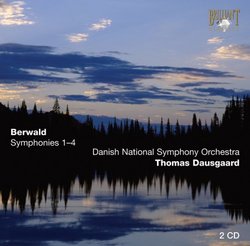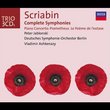| All Artists: Berwald, Dnrso, Dausgaard Title: Berwald: Complete Symphonies Members Wishing: 0 Total Copies: 0 Label: Brilliant Classics Original Release Date: 1/1/2008 Re-Release Date: 6/10/2008 Genre: Classical Style: Symphonies Number of Discs: 2 SwapaCD Credits: 2 UPC: 842977036992 |
Search - Berwald, Dnrso, Dausgaard :: Berwald: Complete Symphonies
 | Berwald, Dnrso, Dausgaard Berwald: Complete Symphonies Genre: Classical
|
Larger Image |
CD DetailsSimilar CDs |
CD ReviewsQuite fine Prescott Cunningham Moore | 10/01/2009 (5 out of 5 stars) "Thomas Dausgaard is one of those conductors at work today that never really turns in a bad performance. Ok, his Schumann cycle for BIS was somewhat underwhelming , but his cycle of the complete symphonies of Langgaard was stunning and his Beethoven simply rocked. Here, Dausgaard turns his attention to the all-too-neglected Swedish master Franz Berwald, and while there are not too many Berwald cycles currently available, Dausgaard blows most out of the water, including Jarvi's, Bjorlin's, and Montgomery's cycles, and can stand proudly next to Sixten Ehrling as a keen and insightful interpreter of this quirky and bizarre early Romantic.
The best performance in this cycle is thankfully the Third, arguably Berwald's greatest work. If I had one complaint about this performance it would be that Dausgaard could elicit slightly more gnarl from the brass in the large tutti passages. That being said, the terraced build of the main theme in the first movement is about as fine as you will find on disc while the finale is a stunning romp through Berwald's idiomatic sound world. The babushka doll second movement, an adagio which houses a scherzo which, in turn, holds a tiny wisp of a trio, is stunning, the return of the adagio after the scherzo hauntingly effective. The Fourth is scarcely less fine, Dausgaard shaping the magnificent slow movement lovingly. The first movement is quite well done as well, featuring some wonderful ensemble work in the development, charming wind chirps leading into the recapitulation. The scherzo is a tad slow for my taste, lacking the vigor you will find in Ehrling or in Markevitch's fabulous Berlin account, and the always problematic start-stop finale sometimes sags a bit, but it improves as it goes along and the coda is perfect, overflowing with Berliozesque oddities. The first and second are less fine, partially because the quality of the music itself is less refined than the Third and Fourth symphonies. The Second especially can sound somewhat diffuse and rambling while the false recapitulation in the First's allegro makes the recapitulation proper sound somewhat anti-climatic. Still, conductors like Sixten Ehrling and Herbert Blomstedt have instilled vigor and energy into these works, bring coherence to these somewhat disparate works. Dausgaard is almost there, but he struggles in the Second to bring order to Berwald's universe. Stronger rhythmic emphasis and a clearer bass line would have added needed weight to the first theme group as well as to the Mendelssohnian development. However, Dausgaard's treatment of the playful, elfish second theme is delightful and the coda is equally fine. The rambling finale is very well played, but Dausgaard's somewhat direct approach makes this repeatitive music outsay its welcome, even if the coda hangs fine and the wind and brass work throughout blazes from the speakers. Dausgaard is best where the music is finest, in the stunning second movement. So fine is Dausgaard and his Danish players that you wish the music lasted longer. The tempo is natural, but flowing, which allows the vivacious central section to have an appropriate bite while preventing the tension to sag during the many pregnant pauses. The First goes more smoothy, if only because it is a better work. Dausgaard shapes up a lovely first movement which, while lacking that last ounce of brio, seemingly overflows with color and an apt sense of fantasy. The winds deserve special mention for their fine ensemble work at the beginning of the development. The scherzo is quite fine as well, with a really sparkling trio. The finale is really something which, in of itself, is a dazzling piece of early romantic orchestration. And Dausgaard really reveals in the beautiful string writing, the charming wind parts, and the big brass outbursts. The development is splendid but the coda could be more incisive, even if the final trombone line is played as soaringly as anyone could ask. The highlight of this performance, like in the second, if the beautiful second movement, which unfolds quite naturally but sounds grand and imposing. The central minor section is sparkling played, especially the deliciously colorful plucked strings. That being said, neither Dausgaard's First nor his Second rises to the level of Sixteen Ehrling in these works. And Herbert Blomstedt's San Francisco First is preferable to Dausgaard's approach as well. Where the Danish players struggle in the scherzo, the San Francisco Symphony articulates with ease. The outer movements feature more involved playing and more convincing interpretations. Dausgaard's thrilling brass work in the finale is certainly appealing at first; however, over repeated hearings, Blomstedt's steadier hand and clearer emphasis on structure stands in a rightful position as a reference reading of this symphony. Still, as a complete cycle, Dausgaard's is only slightly less preferable to Sixten Ehrling's cycle for BIS and is essentially self-recommending to anyone who wants to acquire all the Berwald symphonies for a budget price." |

 Track Listings (8) - Disc #1
Track Listings (8) - Disc #1![Ferdinand Ries: Complete Symphonies [Box Set]](https://nationalbookswap.com/cd//m/66/5166/6145166.jpg)
![Telemann:Tafelmusik (Complete) [Box Set]](https://nationalbookswap.com/cd//m/47/8947/6118947.jpg)

![Glazunov: Symphonies (Complete); Cantatas; Famous Ballet Music; Violin Concerto [Box Set]](https://nationalbookswap.com/cd//m/21/0821/6170821.jpg)
![Hugo Alfvén: Symphonies Nos. 1-5; Swedish Rhapsodies [Box Set]](https://nationalbookswap.com/cd//m/37/5537/6175537.jpg)